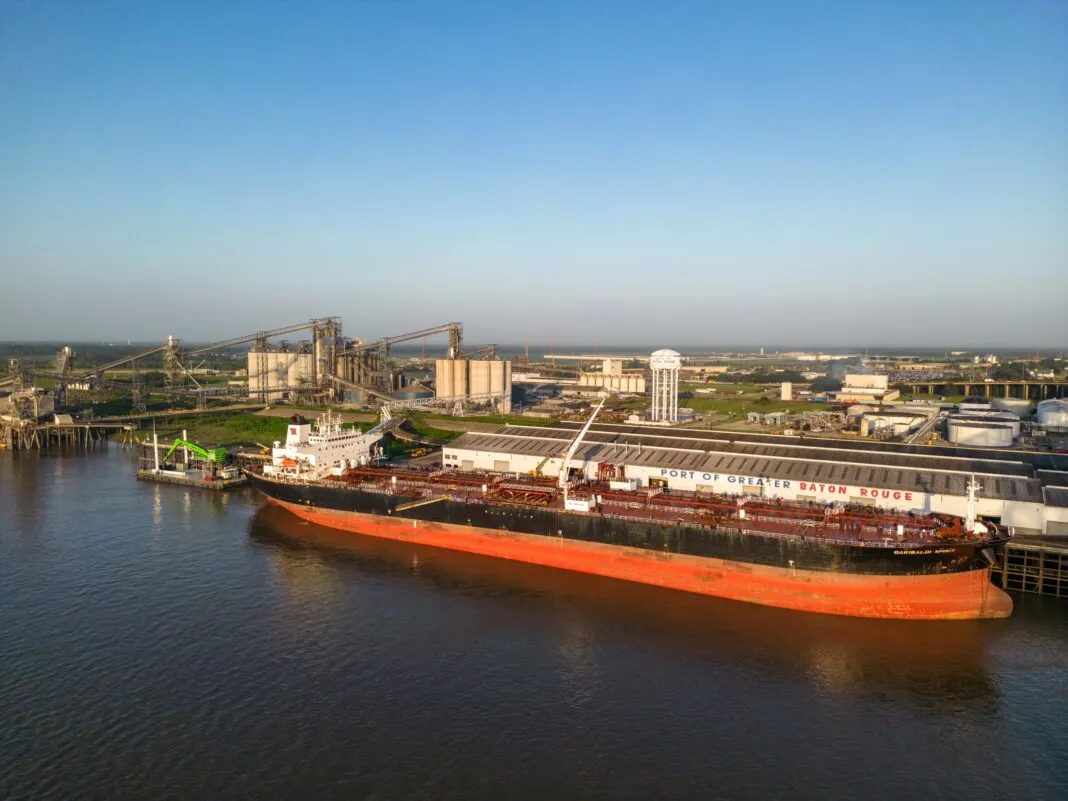
Increasing efficiency and capacity and improving facilities for tenants is always top of mind for the Port of Greater Baton Rouge. An ongoing river deepening project by the U.S. Army Corps of Engineers will only help the Port to remain competitive in shipping commodities and berthing larger deep-draft ships. The draft of the shipping channel from the Gulf of Mexico to Baton Rouge will increase from 45 to 50 feet by 2025, and studies have indicated that each additional foot of draft will add approximately $1 million of cargo value capacity to a vessel.
AT A GLANCE
Top executives: Jay Hardman, P.E., Executive Director
Phone: 225.342.1660
Address: 2425 Ernest Wilson Dr., Port Allen, Louisiana 70767
Website: portgbr.com
Other improvements and developments at the Port involve modernizing infrastructure, allowing for a higher volume of commodities—and making headlines around the country.
Container-on-barge business booming
Unusually low water levels on the Mississippi River in 2020 and 2021 led to a shortage of empty shipping containers throughout the region and dramatically reduced barge traffic north of Baton Rouge and New Orleans.
The container-on-barge business is continuing to rebound to this day, and service at the Port’s Inland Rivers Marine Terminal is booming once again.
The Port is seeking federal funding for expansive growth of infrastructure for the more efficient and voluminous movement of containers. Two pieces of equipment are also continuing to be heavily utilized and play an important role in the efficiency of operations. The “Big Red Beast” is the newest of heavy lift container equipment at the Port. It is in use daily and can load and unload a barge as well as transport and stack containers. The “Reach Stacker” is the other piece of equipment that has resulted in a 20 percent increase in capacity of container storage with its ability to stack containers five high as opposed to four. This has increased the facility’s storage capacity to approximately 1,800 containers.
“This rebound—and increase in efficiency—is once again allowing local industry to choose the option of waterborne transportation from Baton Rouge to New Orleans,” says Port Executive Director Jay Hardman.
Continued growth and anticipated demand are so great that Port staff is considering another expansion of the container handling facility, plus another possible barge dock at their Inland Rivers Marine Terminal.

New barge-mounted pedestal crane assists Louis Dreyfus Commodities
Ordered by the Port to assist tenant Louis Dreyfus Commodities in moving grain from barges into the elevator or onto ships when river levels are extreme, a new, custom-made barge-mounted pedestal crane is in operation at the Louis Dreyfus facility.
Barges can be unloaded in two locations if needed, and there is the additional capability to operate alongside a deep-draft ship. This electrically powered crane can be positioned on the water side of the vessel and used to supplement loading either 25 cubic yards of grain or additional commodities with each scoop of its bucket.
“When the river is extremely high or low, it can make it difficult and sometimes impossible for the grain barge unloading conveyor system to operate efficiently,” explains Hardman. “This new, barge-mounted pedestal crane is always capable of unloading barges directly to truck or deep-draft ship.
“It’s an enhancement as well as insurance to keep grain moving through the elevator and has the potential to increase volume,” adds Hardman. “We look forward to harvest season when we will be able to utilize it to the fullest extent possible.”
Fifth berth rehabilitation on Mississippi River deepwater docks underway
Currently at the Port, four deep-draft ships can berth and unload or load at the same time. An existing fifth berth to be rehabilitated at the northernmost end of the existing deepwater docks has been designed, approved and partially funded. This will be the first major berth expansion since the completion of the Port’s dock extension in 1986.
As ships have gotten bigger over the years, this berth has lagged in its ability to accommodate them. “We are bringing this berth to modern-day standards, which will require additional infrastructure in the river and an upgrade to existing mooring structures,” says Hardman.
The rehabilitation of this fifth berth is estimated to cost approximately $15 million and has received two-thirds of its funding, with the Port ready to supplement funding if necessary to commence construction of the project later this year.
“We are excited about the results of this expansion, which will open up additional dock utilization for continued growth of our wood pellet business,” says Hardman.
GRON FUELS AVIATION PROJECT UNDERWAY
On Earth Day in 2021, Grön Fuels, part of Fidelis New Energy, announced a 65,000-barrel-per-day GigaSystem renewable fuels facility producing sustainable aviation fuel, renewable diesel and green hydrogen utilizing the Port of Greater Baton Rouge’s Inland Rivers Marine Terminal.
The project is still under development, with permits and rights-of-ways having been acquired and the design nearing completion.
Making headlines again in December 2022, Fidelis announced a memorandum of understanding to provide JetBlue with at least 92 million gallons of blended sustainable aviation fuel (SAF) from Grön Fuels at the Port. This SAF is expected to be delivered over a five-year term with a targeted start date of 2025.
Says Port Executive Director Jay Hardman, “We couldn’t be more pleased with Grön’s efforts to develop and begin construction on what will be the world’s largest and best-in-class sustainable aviation fuel and renewable diesel production facility.”
 GET DAILY REPORT FREE
GET DAILY REPORT FREE



